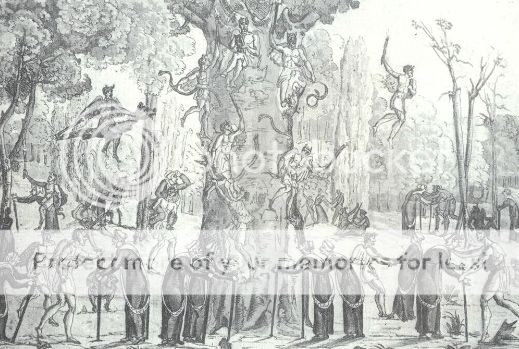-
*Astrella.
User deleted
The Witches of Benevento

Benevento is a historical city located in Italy’s Campania region. Known for its Roman ruins, beautiful women and my mother’s childhood, the city also carries the eerie legend of the Benevento witches. No, my mother does not come from a family of witches – at least I don’t think she does…
The area was originally known as Maleventum (meaning “site of bad events”), until the Romans conquered and renamed it Beneventum (“site of good events”).
Soon after, a Pagan temple was built to worship the goddess Diana. As Christianity grew, the Catholics took leadership, destroyed the temple and claimed the area to be infested by the devil.
The people of Benevento, however, still looked to this area as a place of magic and luck, therefore continued their Pagan rituals and customs there in secret – thus the witch legend began.
Today, Benevento is akin to Salem, Massachusetts in USA, and considered the place where witches from all over the world meet.
With this legend in mind, the creators of the “Witch City’s” most popular liqueur named their elixir Strega.
Strega (meaning “witch”) is a golden liqueur used in many Italian desserts from cakes and cookies to chocolates and gelato. Its label includes images of an ugly witch with a broom and a circle of witches dancing around a tree under a full moon – images inspired by folklore.
We recently made a trip to Benevento to taste a local gelato treat called Mela allo Strega (The Witch’s Apple or Apple of Strega), served specifically at the Caffe Strega. The ‘apple’ was a yellow ball of Strega flavored gelato with a core made of sponge cake soaked in the golden liqueur.


The city of Benevento and the cult of the witches.

The legend says that Benevento was founded by Diomede who landed on the coast of Puglia after the destruction of Troy. Inhabited by Samnite people,
Benevento had a main role for the destiny of italic people, as state the countless archaeological findings discovered in the town and all around it.
Historically it became famous for the first time when native strong warriors defeated the Roman soldiers in the battle of the Forche Caudine and forced them to walk under a bridge made of three forks to let their defeat being public. After that the Romans took revenge for the humiliation of Forche Caudine, Benevento definitely got into Roman's orbit and its name was changed in a more auspicious one: Benevento, after the victory against Pyrrus.
The town followed the economical and political grandeur of Rome thank to its location at the confluence of important consular roads (like Appia road, the regina viarum that took to Brindisi from Rome, Latina road, Traiana road, a shortcut towards the East). It was embellished by the Romans with important buildings and monuments still visible nowadays.
Tito archone of the most important building dating back to the Roman time is the triumphal arch, dedicated to Traiano, built between 114 and 117 A.D. at the beginning of Traiana Road. With only one fornix, it follows the style of Arch of Tito: the face panels and the fornix inside are showing episodes of Traiano's life; the whole ends up with the apotheosis of the emperor.
In the heart of the historical centre of the town there's the Roman theatre. It was built between 200 and 210 A.D. under the Empire of Adriano. It is 90 metres in diameter with three orders of arches and when it was full, it hosted about 20.000 guests.
Those two monuments are strong terms of reference of the ancient splendour of Benevento, because they are preserved almost entirely, but there are other archaeological footprints, not less important, testifying magnificent monuments of an ancient culture: fragments, findings and documents are kept in Museum of Sannio.
Regarding the location of the forum, the historians think that it is situated between the decumanus maximus and the theatre, thanks to some archaeological findings and inscriptions that have been found.
Some of the inscriptions talk about the Isis Temple (goddess of journeys).
The localization of the monument is doubtful; most probably it was in the eastern zone, toward the hill, where the town grew up in Traiano's age. It was built by will of Domiziano in 88 A.D., and is was destroyed around V-IV century A.D.; it became, probably, a quarry of stones and marble, to be used in new buildings of the town. That theory explains the findings of Egyptians sculptures and two obelisks close to the forum.
When the monumental temple was built, in the town mysterious rites and eastern cults started to be practiced. Isis, goddess of the moon with its night rites, goddess capable of spells and wealth; Isis, famous for the myth of Osiride, her brother and husband, from which (even if dead) she has a son.
And still, the sacred tree, that appears in the goddess'life,at the branches of which Osiride was hung, when his brother Set, in the first attempt at his life, fastened him at the bottom of the river in the Busiri Delta.
The goddess dipped, cut the tree, and saved her husband. The legend says that a snake with a golden cup appeared out of the part which was left of the trunk and the tree began to grow again.
There in the Middle Ages, women experts in the art of herbs and medicine, started to gather under a great walnut in the forest near their city. They were called in the local dialect ianara, a mispelling from dghianara, i.e. Dianara, the child of Diana, who like Isis was the goddess of the birth and of the death.
From Longobards, who kept the city after the fall of Roman Empire, ianare learned the pagan cults praticed under walnut trees (the holy tree to the god of Longobard's ancestor, Wotan): these women spent their nights wandering in the forests of Sannio near the shores of the river Sabatum, and after the name of this river, their strange activities were easily turned into the famous Sabbath of the Witches.
Secular magical practices, superstition and popular fantasy made the rest, so much to label Benevento as the town of magic. In the year 622 A.D. the Saint Barbato converted the longobard Duke Arechi II of Benevento to Christianity and had the tree cut down, in order to eradicate the pagan rites(at least that was the intent; it seems that the legendary rite of witches survived until the beginning of XX century).
Since those times, the town started to become enriched with churches and monasteries, gaining again its role as a town of culture and art.
Saint Sofia, church strongly wanted from magnificent prince Arechi II, represented the most refined and highly architectural realization of Longobard's faith in the town and in southern Italy. The prince, refined cultural man (so much to be even loved by his brother in law Charlemangne, who vainly tried to subject him to the political control of his reign), had in his court artists from Syria and Palestine, whose style is found in the remains of frescos from Saint Sofia and from the Crypt of the Cathedral.
After such a big brightness, the town fell in a not much blooming period: the principality shattered, and Salerno and Capua were the opposers of its political role, so that Benevento declined.
Then, with the come of the Saracens and then the Normans, which devastated many areas of the Sannio, forced Benevento to fall into the arms of the Papa's Church, staying as a window of the Pope's State in southern Italy until the National Unity.
The medieval settlement was characterized by the presence of the castle (then called Rocca dei Rettori) and of some religious building, the Roman-Gothic Cathedral among the others. In 1688 and in 1722 Benevento was torn down by two catastrophic earthquakes. The rebuilding work gave to the town the elegant late-baroque characteristics, that are still visible. The most ancient parts of the town are still connoted by Longobard walls.
On the other side, the French invasion and domination of Talleyrand, appointed Prince of Benevento by Napoleon, who wanted to export with weapons the transalpine Jacobinism, are still visible in the monumental fountain located in front of church of Saint Sofia.
The architecture of the Church of S. Sofia is very interesting thank to its general plan, consisting of a central part in a hexagon shape, whose edges are connected to six big columns (probably deriving from the ancient Temple of Isis) and are connected to one another by arches on which the dome extends. Inside there are fragments of the original frescoes.
The church itself is also seat of the Sannio Museum, where to admire the vestments of the Temple of Isis, one of the most consistent Egyptian nucleus ever to be discovered out of Egypt, as well as evidences of the Roman and the medieval time.
Sources: http://moderncultureitaly.wordpress.com/20...s-of-benevento/
www.sorrentofirstchoice.com/en/special-benevento.htm.
The Witches of Benevento28 Luglio 2013 |


